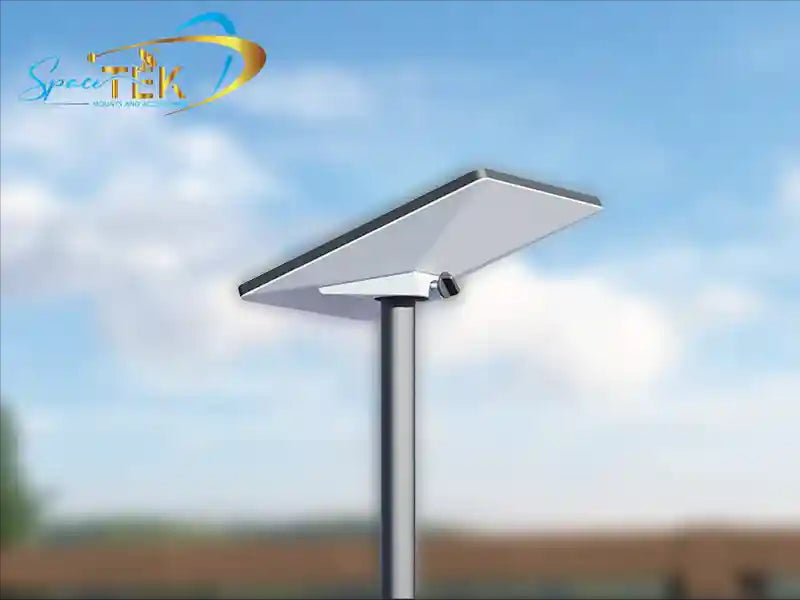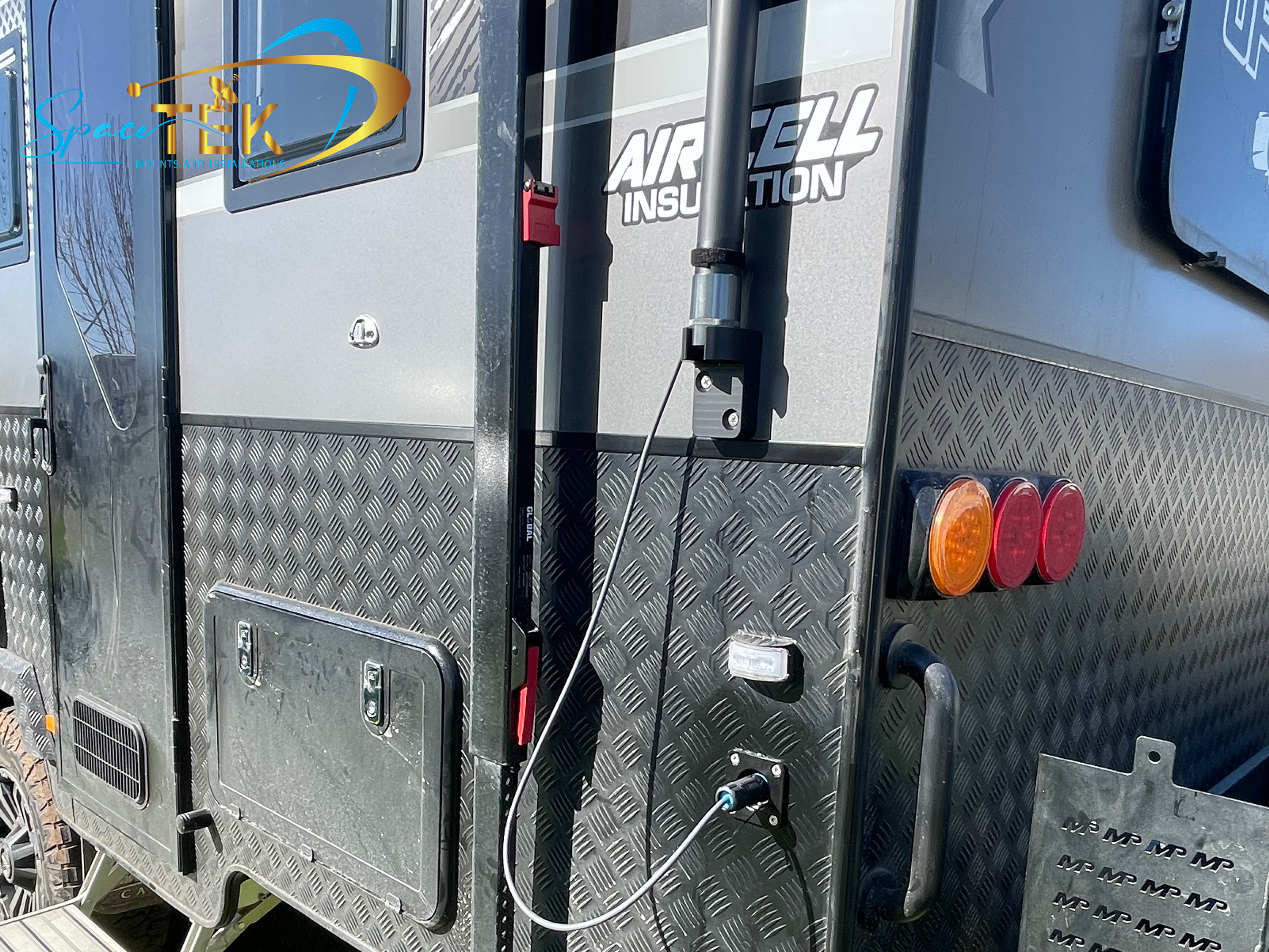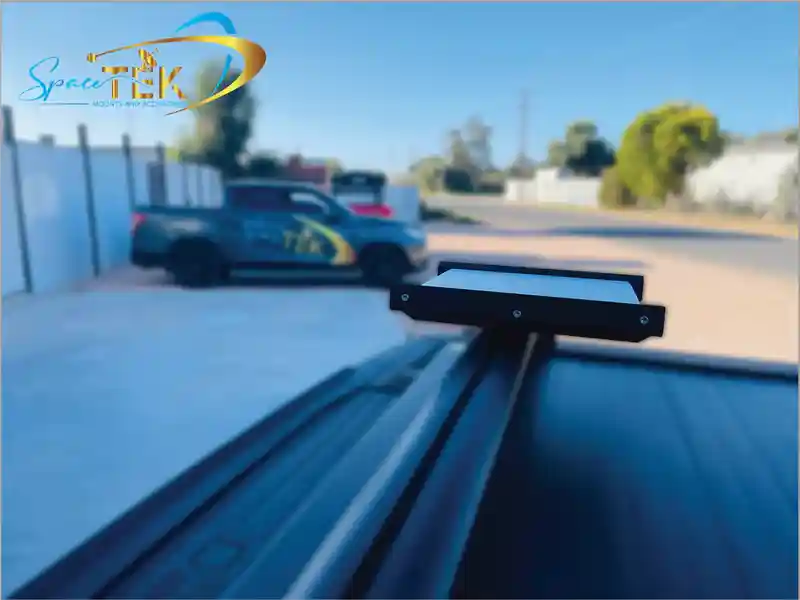Why the Right Mount Matters for Your Portable Starlink Mini
How Should You Mount a Starlink Mini? Here's the quick answer:
Best Starlink Mini Mounting Options:
- Magnetic Mounts - Quick attachment to metal vehicle roofs; ideal for temporary use; tested at 70+ mph
- Universal Clamp Mounts - Fits roof racks 12-48mm thick; secure without drilling; works on any vehicle type
- Pole Mounts - Lifts dish for better signal; suits permanent rural installations; compatible with pipes up to 41.9mm
- In-Motion Mounts - Low-profile aerodynamic design; maintains connection while driving; built for Australian highways
Key Factor: Choose based on your use case. Permanent home setups need elevation and weather resistance, while mobile users must prioritise stability at speed and easy removal.
The Starlink Mini is brilliantly portable, weighing just 1.2 kg. But its built-in kickstand isn't designed for the challenges of the Australian landscape.
The kickstand sits too low, making it vulnerable to signal obstruction from trees, buildings, or even your own vehicle. A strong gust of wind can topple it, it offers no protection from theft, and it simply can't provide the stable connection needed for in-motion use.
I'm Aaron Wroblewski, founder of SpaceTek Australia. With over 25 years working with satellite systems, I've seen that matching the right mount to your specific environment is the key to reliable connectivity—whether you're dealing with coastal salt spray, outback dust, or highway travel at 110 km/h.
Mounting options for Starlink Mini
The Starlink Mini's compact design is a game-changer for portable internet, but its performance hinges on two fundamentals: a clear, unobstructed view of the sky and rock-solid stability. Even minor obstructions like tree branches can cause dropped connections. A proper mount isn't just for holding the dish; it's for positioning it precisely for the strongest, most reliable signal.
A Guide to Starlink Mini Mount Types
Choosing the right mount depends entirely on your needs. For a complete rundown, see our comprehensive guide on Starlink Mini mounting options.
- Magnetic mounts are excellent for temporary setups on steel surfaces. Our SpaceTek mounts offer incredible convenience and are tested for highway speeds, but they aren't ideal for long-term, unattended use or rough terrain.
- Universal mounts, including our clamp and pole varieties, offer true versatility. Our clamp mounts attach securely to roof racks without drilling, while our pole mount adapters are invaluable for lifting the dish above obstructions. They require basic tools for installation, making them less instant than magnetic options.
- Permanent bolt-on mounts are the ultimate solution for fixed installations on RVs or caravans where maximum stability and security are required. Our Universal Mount can be bolted on, offering peace of mind for long-term use in extreme conditions but requires drilling for permanent modification.
Factors to Consider Before You Mount
Making the right choice depends on your specific situation. For more help, check our detailed guide on Starlink Mini mounts for Australians.
- Use Case: Are you a weekend camper needing a temporary setup or an RVer requiring a stable, in-motion connection? Your answer determines the right mount.
- Vehicle Type: A steel roof allows for magnetic mounts, while a fibreglass RV may need clamps or bolt-on solutions. Vehicle aerodynamics and vibration also affect performance.
- Environment: Your mount must withstand Australia's harsh conditions, from scorching sun and torrential rain to corrosive coastal salt spray. For marine environments, stainless steel hardware is essential. You can find real-world research on marine corrosion prevention on forums like Sailing Anarchy.
- In-Motion vs. Stationary: For use while driving, a mount tested for highway speeds (70+ mph) is non-negotiable. For stationary use, wind resistance is still a key factor.
- Material and GPS Interference: Starlink warns that metal mounts near the GPS chip (top-right back corner) can cause interference. We recommend mounts made from non-metallic materials like marine-grade HDPE or aluminium designs that keep metal away from this sensitive area.
- Durability: To last in Australia's climate, your mount needs corrosion-resistant materials. Stainless steel hardware is a wise investment for long-term reliability.
Best Mounts for RVers, Campers, and Permanent Setups
Different adventurers need different solutions. If you're an RVer, our article on mounting Starlink Mini on your RV roof has you covered.

- For RVers and Van Lifers: Robust, stable mounts capable of in-motion use are essential. Look for options tested at highway speeds. Our mounts are engineered for Australian heat and dust, with some featuring reflective hardtops for heat management and protection.
- For Weekend Campers: Portability is key. Magnetic mounts are perfect for quick setup and pack-down. A simple pole mount is also great for getting the dish above low-lying obstructions.
- For Permanent Installations: Stability and obstruction clearance are paramount. A sturdy pole or permanent roof mount ensures a clear line of sight to the satellites, maximising uptime. Our Universal Mount provides a durable, weather-resistant solution for fixed setups.
For more on staying connected while travelling, explore our guide on mounting for Starlink Mini in motion.
Installation, Performance, and Long-Term Care
How Should You Mount It for Peak Performance?
Proper mounting is about giving your Starlink Mini what it needs to perform at its best.
- Signal Optimisation: A clear sky view is non-negotiable. Use the Starlink app's obstruction tool to find the perfect spot, and mount the dish as high as practical to minimise blockages.
- GPS Interference Prevention: The Mini's GPS chip is sensitive to nearby metal. This is why we champion marine-grade HDPE in our designs—it's durable, weather-resistant, and transparent to GPS signals. If using an aluminium mount, ensure it's engineered to keep metal away from the critical GPS area.
Cable Management: Protect your cables from UV damage and physical wear. Route them thoughtfully, using conduits or UV-resistant covers to keep everything neat, secure, and safe.
Power Integration: The Starlink Mini supports 12V operation, perfect for direct connection to a vehicle or caravan battery. This eliminates the need for bulky inverters and reduces power consumption. Our guide on 12-56V DC Power Supplies for Portable and RV Use can help you choose the right solution for off-grid adventures.
How Should You Mount It to Withstand Speed and Weather?
Your mount must protect your investment from everything Australia throws at it. For more details, see our article on Stay Connected in Motion: Mounting for Starlink Mini.
For in-motion use, highway speed stability is critical. Mounts designed for this purpose feature aerodynamic, low-profile designs to minimise drag and prevent failure at 110 km/h. Quality mounts also incorporate vibration dampening to protect your equipment on corrugated outback roads.
Australian conditions also demand serious heat management. The Starlink Mini's operating limit is 50°C, but a dark surface in the sun can get much hotter. Features like reflective hardtops or polycarbonate shields help manage heat and protect against hail. Our mounts are engineered with corrosion-resistant materials to handle torrential rain, dust, and coastal salt spray.
Securing and Maintaining Your Investment
Theft prevention should be part of your mounting strategy. Look for mounts with security fasteners or designs that deter quick removal. Our range of Starlink Mini accessories includes options designed with security in mind.
For long-term reliability, adopt simple maintenance best practices. A quick monthly inspection of fasteners and cables can prevent major headaches. Every few months, give the dish and mount a gentle clean to remove dust and salt, which can accelerate wear. In coastal areas, pay extra attention to rinsing salt spray off all hardware.
Finally, protect exposed cabling from UV damage with UV-resistant conduit. It's a small cost that significantly extends the life of your installation. By combining a quality, purpose-built mount from SpaceTek Australia with regular maintenance, you guarantee reliable internet wherever your adventures take you.
Conclusion
Your Starlink Mini offers incredible freedom, but its potential is only open uped with the right mount. Mounting is critical because your choice directly impacts signal quality, connection stability, and the longevity of your investment.
As we've covered, the ideal solution depends on your needs. An RVer requires in-motion stability, a camper values portability, and a permanent setup demands elevation and weather resistance. Technical details like ensuring a clear line of sight and avoiding GPS interference are just as crucial.
At SpaceTek Australia, we draw on over 25 years of satellite experience to engineer mounting kits specifically for Australian conditions. Our high-quality, rust-resistant mounts are not copies of overseas designs; they are built to withstand outback dust, coastal salt, and everything in between. They integrate seamlessly with your Starlink, ensuring your dish is secure and positioned for peak performance.
Don't compromise your connection with a flimsy bracket. Your access to work, family, and safety deserves a solution built for the real world.
Ready to find the perfect mount for your Starlink Mini? For expert advice custom to your setup, please contact us – we'll make sure you stay connected, wherever the road takes you.



Leave a comment
This site is protected by hCaptcha and the hCaptcha Privacy Policy and Terms of Service apply.